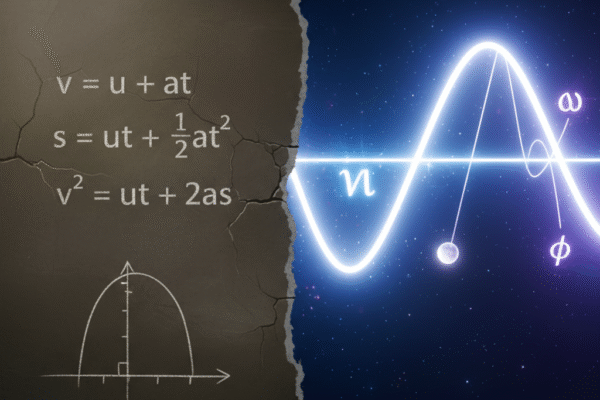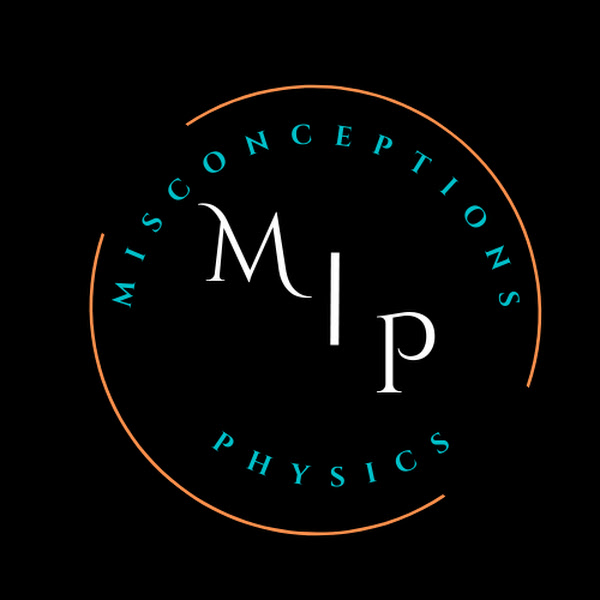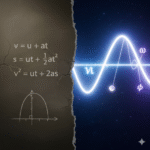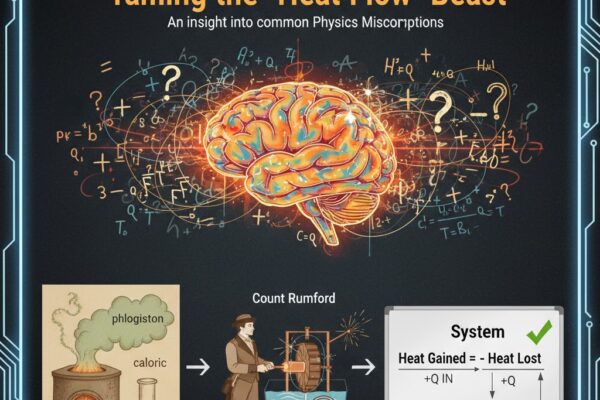
The Secret Language of Oscillations: Why Your Favorite Physics Equations Fail for SHM
When Your Go-To Equations Give Up Think about the world around you: a pendulum swinging in a clock, a guitar string vibrating to make a note, or even a bungee jumper bouncing up and down. These are all examples of a special kind of rhythmic motion called Simple Harmonic Motion (SHM). In your physics class, you’ve probably become good friends with the kinematics equations: These equations are fantastic for figuring out the motion of a ball thrown in the air or a car accelerating down a road. But here’s the puzzle: the moment you try to use them on a swinging pendulum or a bouncing spring, they completely fail. Why do these powerful tools fall silent when faced with the simple, repeating dance of SHM? Let’s find out. The Core Problem: A Constantly Changing Acceleration The kinematics equations you know and love have one critical weakness: they only work when acceleration is constant. For SHM, acceleration is the exact opposite—it’s always changing! This leads to one of the most common misconceptions. Consider a typical exam question from one of our videos: The acceleration of the object is always proportional to its displacement, and it points in the opposite direction. Think of a spring: the more you stretch it (more displacement), the harder it pulls back (more acceleration). When the mass is at the center (zero displacement), the spring isn’t pulling at all, so the acceleration is zero. Because ‘a’ is never constant in SHM, you simply can’t plug it into v = u + at. We need a new set of tools. The Story of a Breakthrough: How We Cracked the Code Understanding SHM wasn’t a single “Eureka!” moment. It was a journey of discovery by some of history’s greatest scientific minds. Galileo’s Experiment: While sitting in a cathedral, Galileo noticed a lamp swinging [1]. Using his own pulse as a timer, he was amazed to find that each complete swing took the same amount of time, no matter how wide or narrow the swing was (for small angles). This told him there was a consistent rhythm, a constant period, to this motion. Hooke’s Law Hooke was obsessed with springs. He discovered a simple but powerful rule now called Hooke’s Law: the force a spring uses to pull back is directly proportional to how far you stretch it (F = -kx). This was the key! He found the mathematical reason for the changing acceleration. More stretch = more force = more acceleration. You can access his original paper at the internet archive [2] Isaac Newton (Late 1600s): Newton brought it all together. He took his Second Law of Motion (F=ma) and combined it with Hooke’s Law (F=−kx). This gave birth to the master equation of SHM: ma = -kx. This equation officially proved that acceleration (a) is not constant—it’s directly proportional to displacement (x). With his invention of calculus, Newton was able to solve this equation, giving us a whole new way to describe motion. The New Toolkit: Understanding Path and Phase Solving Newton’s master equation gives us a beautiful, wavy solution that looks like this: This might look complicated, but it introduces three powerful new concepts that perfectly describe SHM: This new language helps us solve problems that the old equations couldn’t touch. For example, understanding phase is key to answering questions like this: Video Example: A particle executes simple harmonic oscillations. What is the phase difference between the acceleration and the displacement of the particle? Let’s think about the very heart of Simple Harmonic Motion. An object in SHM is always being pulled back towards its center or equilibrium position. This “restoring force” is key. It means the direction of the force is always trying to counteract the object’s position. This leads to a classic question: In simple harmonic oscillations which two quantities always have opposite directions? Why Does This Matter? SHM is Everywhere! Understanding SHM isn’t just for passing exams; it’s fundamental to how the universe works. A Final Thought: Don’t Fear “Failed” Equations In TOK, we learn that scientific models are not reality itself; they are simplified maps designed for a specific purpose. The fact that your trusty kinematics equations—a powerful model for constant acceleration—don’t work for SHM isn’t a failure. Instead, it’s a discovery of the model’s scope and limitations. 🗺️ This moment is an invitation to ask a classic knowledge question: To what extent does the failure of a scientific model contribute to the growth of knowledge? This situation perfectly demonstrates a core principle of the Natural Sciences as an Area of Knowledge (AOK): knowledge progresses not by proving things right, but by finding out where our current understanding is wrong. These “failures” are the catalysts for creating more comprehensive and powerful models. So, as a knower, embrace these moments. When a problem doesn’t fit your initial framework, it’s not a dead end. It’s a sign that you are moving from a simple map to a more detailed one, pushing the boundaries of both your personal and shared knowledge. Keep questioning your assumptions, keep challenging your models, and keep exploring the rich complexity of the universe. 🤔 Bibliography:







